维多利亚时代【英文】 victorian period
- 格式:ppt
- 大小:237.50 KB
- 文档页数:21
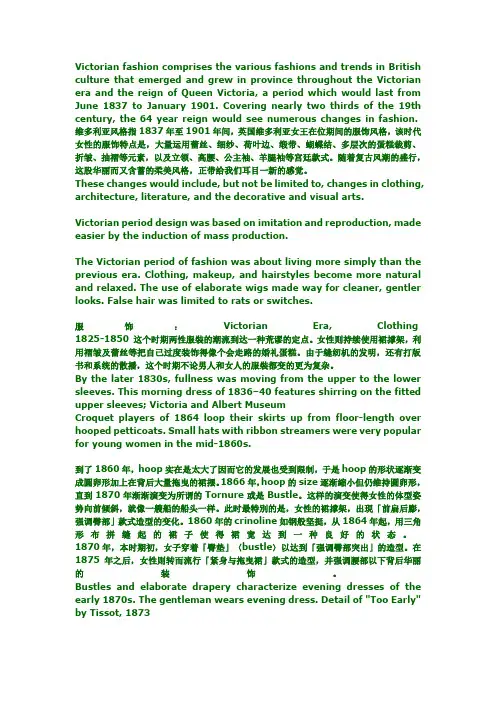
Victorian fashion comprises the various fashions and trends in British culture that emerged and grew in province throughout the Victorian era and the reign of Queen Victoria, a period which would last from June 1837 to January 1901. Covering nearly two thirds of the 19th century, the 64 year reign would see numerous changes in fashion. 维多利亚风格指1837年至1901年间,英国维多利亚女王在位期间的服饰风格,该时代女性的服饰特点是,大量运用蕾丝、细纱、荷叶边、缎带、蝴蝶结、多层次的蛋糕裁剪、折皱、抽褶等元素,以及立领、高腰、公主袖、羊腿袖等宫廷款式。
随着复古风潮的盛行,这股华丽而又含蓄的柔美风格,正带给我们耳目一新的感觉。
These changes would include, but not be limited to, changes in clothing, architecture, literature, and the decorative and visual arts.Victorian period design was based on imitation and reproduction, made easier by the induction of mass production.The Victorian period of fashion was about living more simply than the previous era. Clothing, makeup, and hairstyles become more natural and relaxed. The use of elaborate wigs made way for cleaner, gentler looks. False hair was limited to rats or switches.服饰:Victorian Era, Clothing 1825-1850 这个时期两性服裝的潮流到达一种荒谬的定点。
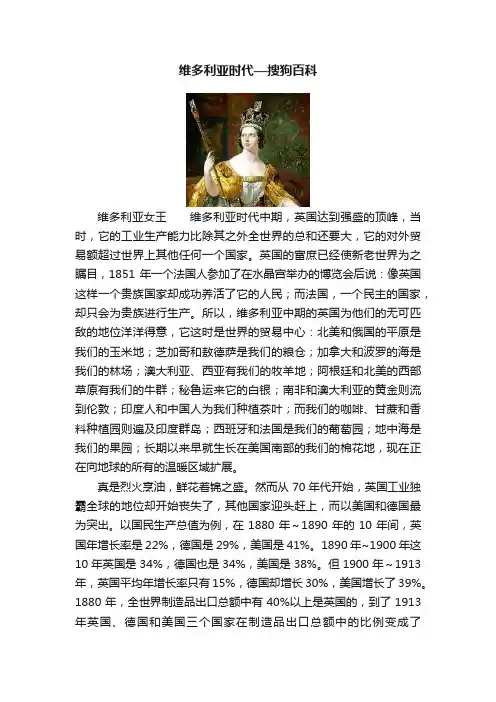
维多利亚时代—搜狗百科维多利亚女王维多利亚时代中期,英国达到强盛的顶峰,当时,它的工业生产能力比除其之外全世界的总和还要大,它的对外贸易额超过世界上其他任何一个国家。
英国的富庶已经使新老世界为之瞩目,1851年一个法国人参加了在水晶宫举办的博览会后说:像英国这样一个贵族国家却成功养活了它的人民;而法国,一个民主的国家,却只会为贵族进行生产。
所以,维多利亚中期的英国为他们的无可匹敌的地位洋洋得意,它这时是世界的贸易中心:北美和俄国的平原是我们的玉米地;芝加哥和敖德萨是我们的粮仓;加拿大和波罗的海是我们的林场;澳大利亚、西亚有我们的牧羊地;阿根廷和北美的西部草原有我们的牛群;秘鲁运来它的白银;南非和澳大利亚的黄金则流到伦敦;印度人和中国人为我们种植茶叶;而我们的咖啡、甘蔗和香料种植园则遍及印度群岛;西班牙和法国是我们的葡萄园;地中海是我们的果园;长期以来早就生长在美国南部的我们的棉花地,现在正在向地球的所有的温暖区域扩展。
真是烈火烹油,鲜花着锦之盛。
然而从70年代开始,英国工业独霸全球的地位却开始丧失了,其他国家迎头赶上,而以美国和德国最为突出。
以国民生产总值为例,在1880年~1890年的10年间,英国年增长率是22%,德国是29%,美国是41%。
1890年~1900年这10年英国是34%,德国也是34%,美国是38%。
但1900年~1913年,英国平均年增长率只有15%,德国却增长30%,美国增长了39%。
1880年,全世界制造品出口总额中有40%以上是英国的,到了1913年英国、德国和美国三个国家在制造品出口总额中的比例变成了29.9%、26.4%和12.6%,英国的下滑趋势是十分明显的。
当然这只是相对下滑,从绝对数字上看,英国仍是世界上最富有的国家,维多利亚时代最显著的特征之一就是它的富庶,直至它结束时都是这样。
然而这种富庶更像是一种罪恶,在维多利亚时代,财富的分配始终不均,贫富对比十分明显。
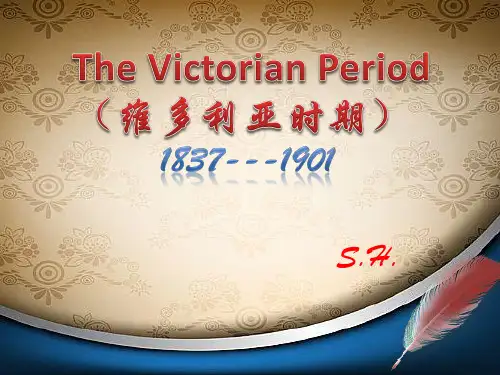
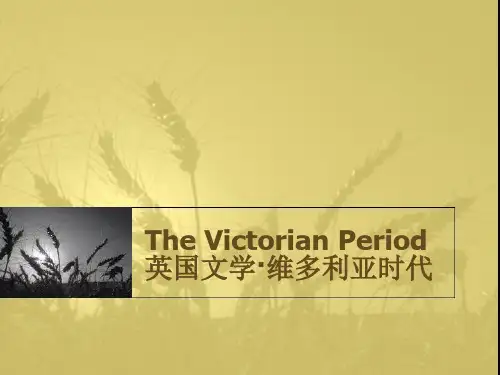
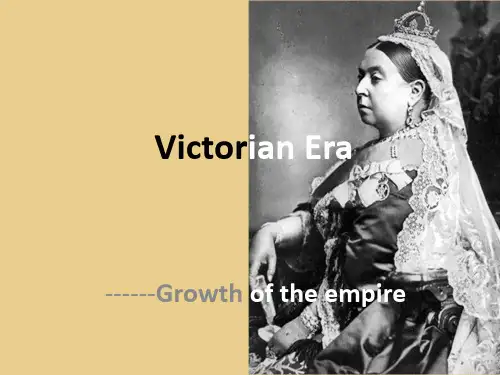
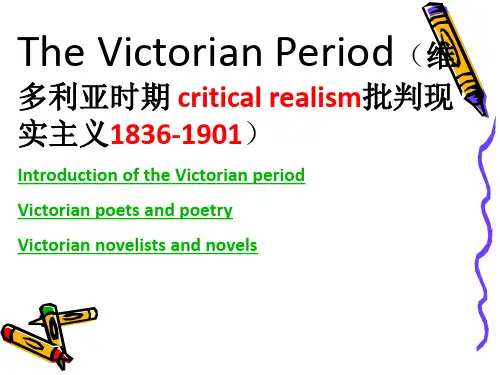
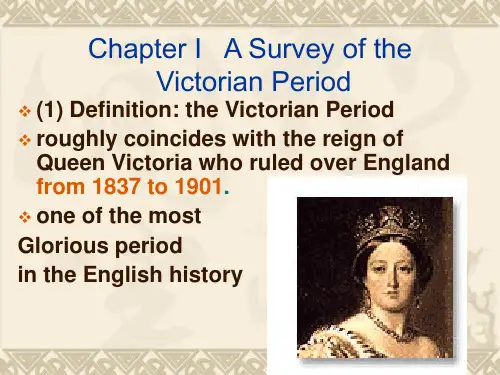
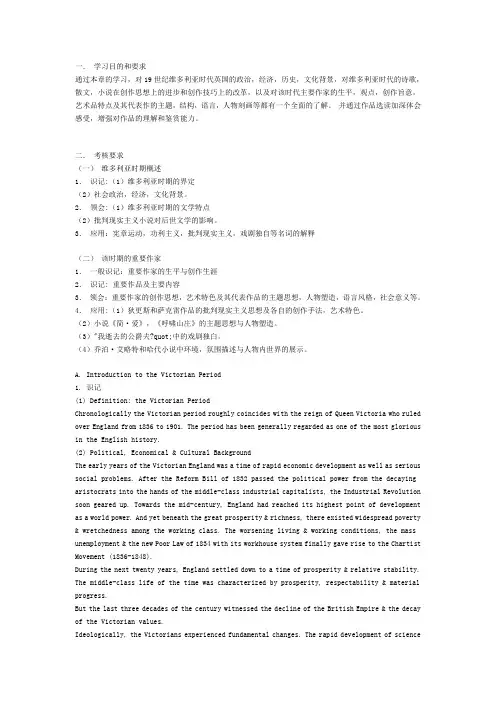
一.学习目的和要求通过本章的学习,对19世纪维多利亚时代英国的政治,经济,历史,文化背景,对维多利亚时代的诗歌,散文,小说在创作思想上的进步和创作技巧上的改革,以及对该时代主要作家的生平,观点,创作旨意,艺术品特点及其代表作的主题,结构,语言,人物刻画等都有一个全面的了解。
并通过作品选读加深体会感受,增强对作品的理解和鉴赏能力。
二.考核要求(一)维多利亚时期概述1.识记:(1)维多利亚时期的界定(2)社会政治,经济,文化背景。
2.领会:(1)维多利亚时期的文学特点(2)批判现实主义小说对后世文学的影响。
3.应用:宪章运动,功利主义,批判现实主义,戏剧独自等名词的解释(二)该时期的重要作家1.一般识记:重要作家的生平与创作生涯2.识记: 重要作品及主要内容3.领会:重要作家的创作思想,艺术特色及其代表作品的主题思想,人物塑造,语言风格,社会意义等。
4.应用:(1)狄更斯和萨克雷作品的批判现实主义思想及各自的创作手法,艺术特色。
(2)小说《简·爱》,《呼啸山庄》的主题思想与人物塑造。
(3)"我逝去的公爵夫?quot;中的戏剧独白。
(4)乔泊·艾略特和哈代小说中环境,氛围描述与人物内世界的展示。
A. Introduction to the Victorian Period1. 识记(1) Definition: the Victorian PeriodChronologically the Victorian period roughly coincides with the reign of Queen Victoria who ruled over England from 1836 to 1901. The period has been generally regarded as one of the most glorious in the English history.(2) Political, Economical & Cultural BackgroundThe early years of the Victorian England was a time of rapid economic development as well as serious social problems. After the Reform Bill of 1832 passed the political power from the decaying aristocrats into the hands of the middle-class industrial capitalists, the Industrial Revolution soon geared up. Towards the mid-century, England had reached its highest point of development as a world power. And yet beneath the great prosperity & richness, there existed widespread poverty & wretchedness among the working class. The worsening living & working conditions, the mass unemployment & the new Poor Law of 1834 with its workhouse system finally gave rise to the Chartist Movement (1836-1848).During the next twenty years, England settled down to a time of prosperity & relative stability. The middle-class life of the time was characterized by prosperity, respectability & material progress.But the last three decades of the century witnessed the decline of the British Empire & the decay of the Victorian values.Ideologically, the Victorians experienced fundamental changes. The rapid development of science& technology, new inventions & discoveries in geology, astronomy, biology & anthropology drastically shook people's religious convictions. Darwin's The Origin of Species (1859) & The Descent of Man (1871) shook the theoretical basis of the traditional faith. On the other hand, Utilitarianism was widely accepted & practiced. Almost everything was put to the test by the criterion of utility, that is, the extent to which it could promote the material happiness.2. 领会(1) Features of the Victorian LiteratureVictorian literature, as a product of its age, naturally took on its quality of magnitude & diversity. It was many-sided & complex, & reflected both romantically & realistically the great changes that were going on in people's life & thought. Great writers & great works abounded.(2) Features of Victorian novelsIn this period, the novel became the most widely read & the most vital & challenging expression of progressive thought. While sticking to the principle of faithful representation of the18th-century realist novel, novelists in this period carried their duty forward to the criticism of the society & the defense of the mass. Although writing from different points of view & with different techniques, they shared one thing in common, that is, they were all concerned about the fate of the common people. They were angry at the inhuman social institutions, the decaying social morality as represented by the money-worship & Utilitarianism & the widespread misery, poverty & injustice. Their truthful depiction of people's life & bitter & strong criticism of the society had done much in awakening the public consciousness to the social problems & in the actual improvement of the society.Victorian literature, in general, truthfully represents the reality & spirit of the age. The high-spirited vitality, the down-to-earth earnestness, the good-natured humor & unbounded imagination are all unprecedented. In almost every genre it paved the way for the coming century, where its spirits, values & experiments are to witness their bumper harvest.3. 应用 Definitions of several terms1) The Chartist Movement (1836-1848)The English workers got themselves organized in big cities & brought forth the People's charter, in which they demanded basic rights & better living & working conditions. They, for three times, made appeals to the government, with hundreds of thousands of people's signatures. The movement swept over most of the cities in the country. Although the movement declined to an end in 1848, it did bring some improvement to the welfare of the working class. This was the first mass movement of the English working class & the early sign of the awakening of the poor, oppressed people.2) UtilitarianismAlmost everything was put to the test by the criterion of utility, that is, the extent to which it could promote the material happiness. This theory held a special appeal to the middle-class industrialists, whose greed drove them to exploiting workers to the utmost & brought greater suffering & poverty to the working mass.3) Critical RealismThe Victorian Age is an age of realism rather than of romanticism-a realism which strives to tell the whole truth showing moral & physical diseases as they are. To be true to life becomes the first requirement for literary writing. As the mirror of truth, literature has come very close to daily life, reflecting its practical problems & interests & is used as a powerful instrumentof human progress.4) Dramatic MonologueBy dramatic monologue, it is meant that a poet chooses a dramatic moment or a crisis, in which his characters are made to talk about their lives, & about their minds & hearts. In " listening" to those one-sided talks, readers can form their own opinions & judgments about the speaker's personality & about what has really happened. Robert Browning brought this poetic form to its maturity & perfection & his "My Last Duchess" is one of the best-known dramatic monologues.>> 点击下载资料/index.php?action-viewnews-itemid-83743-php-1B. Victorian WritersI. Charles Dickens1.一般识记 His Life & Literary CareerCharles Dickens (1812-1870) was born at Portsmouth. His father, a poor clerk in the Navy Pay office, was put into the Marsalsea Prison for debt when young Charles was only 12 years old. The son had to give up schooling to work in an underground cellar at a shoe-blacking factory - a position he considered most humiliating. We find the bitter experiences of that suffering child reflected in many of Dickens's novels. In 1827, Charles entered a lawyer's office, & two years later he became a Parliamentary reporter for newspapers. From 1833 Dickens began to write occasional sketches of London life, which were later collected & published under the title Sketches by Boz (1836). Soon The Posthumous Papers of the Pickwick Club (1836-1837) appeared in monthly installments. And since then, his life became one of endless hard work. In his later years, he gave himself to public readings of his works, which brought plaudits & comfort but also exhausted him. In 1870, this man of great heart & vitality died of overwork, leaving his last novel unfinished.2. 识记His Major WorksUpon his death, Dickens left to the world a rich legacy of 15 novels & a number of short stories. They offer a most complete & realistic picture of English society of his age & remain the highest achievement in the 19th-century English novel. In nearly all his novels, behind the gloomy pictures of oppression & poverty, behind the loud humor & buffoonery, is his gentleness, his genial mirth, & his simple faith in mankind.The following is a list of his novels & other collections in three periods:(1) Period of youthful optimistSketches by Boz (1836); The Posthumous Papers of the Pickwick Club (1836-1837); Oliver Twist (1837-1838); Nicholas Nickleby (1838-1839); The Old Curiosity Shop (1840-1841); Barnaby Rudge(1841)(2) Period of excitement & irritationAmerican Notes (1842); Martin Chuzzlewit (1843-1845); A Christmas Carol (1843); Dombey & Son (1846-1848); David Copperfield (1849-1850)(3) Period of steadily intensifying pessimismBleak House (1852-1853); Hard Times (1854); Little Dorrit (1855-1857); A Tale of Two Cities (1859); Great Expectations (1860-1861); Our Mutual Friend (1864-1865); Edwin Drood (unfinished)(1870)3. 领会 Distinct Features of His Novels(1) Character Sketches & ExaggerationIn his novels are found about 19 hundred figures, some of whom are really such " typical characters under typical circumstances," that they become proverbial or representative of a whole group of similar persons.As a master of characterization, Dickens was skillful in drawing vivid caricatural sketches by exaggerating some peculiarities, & in giving them exactly the actions & words that fit them: that is, right words & right actions for the right person.(2) Broad Humor & Penetrating SatireDickens is well known as a humorist as well as a satirist. He sometimes employs humor to enliven a scene or lighten a character by making it (him or her) eccentric, whimsical, or laughable. Sometimes he uses satire to ridicule human follies or vices, with the purpose of laughing them out of existence or bring about reform.(3) Complicated & Fascinating PlotDickens seems to love complicated novel constructions with minor plots beside the major one, or two parallel major plots within one novel. He is also skillful at creating suspense & mystery to make the story fascinating.(4) The Power of ExposureAs the greatest representative of English critical realism, Dickens made his novel the instrument of morality & justice. Each of his novels reveals a specific social problem.4. 领会 His Literary Creation & Literary AchievementsCharles Dickens is one of the greatest critical realistic writers of the Victorian Age. It is his serious intention to expose & criticize in his works all the poverty, injustice, hypocrisy & corruptness he saw all around him. In his works, Dickens sets a full map & a large-scale criticism of the 19th-century England, particularly London. A combination of optimism about people & realism about society is obvious in these works. His representative works in the early period include Oliver Twist, David Copperfield & so on.His later works show a highly conscious modern artist. The settings are more complicated; the stories are better structured. Most novels of this period present a sharper criticism of social evils & morals of the Victorian England, for example, Bleak House, Hard Times, Great Expectations & so on. The early optimism could no more be found.Charles Dickens is a master story-teller. His language could, in a way, be compared with Shakespeare's. His humor & wit seem inexhaustible. Character-portrayal is the most outstanding feature of his works. His characterizations of child (Oliver Twist, etc.), some grotesque people (Fagin, etc.) & some comical people (Mr. Micawber, etc.) are superb. Dickens also employs exaggeration in his works. Dickens's works are also characterized by a mixture of humor & pathos.5. 应用 Selected ReadingAn Excerpt from Chapter III of Oliver TwistThe novel is famous for its vivid descriptions of the workhouse & life of the underworld in the 19th-century London. The author's intimate knowledge of people of the lowest order & of the city itself apparently comes from his journalistic years. Here the novel also presents Oliver Twist as Dickens's first child hero & Fagin the first grotesque figure.This section, Chapter III of the novel, is a detailed account of how he is punished for that "impious & profane offence of asking for more" & how he is to be sold. At three pound ten, to Mr. Gamfield, the notorious chimneysweeper. Though we can afford a smile now & then, we feel more the pitiable state of the orphan boy & the cruelty & hypocrisy of the workhouse board.II. The Bronte Sisters1. 一般识记 Their lives & literary CareerCharlotte Bronte (1816-1855), Emily Bronte (1818-1848), & their gifted sister Anne Bronte (1820-1849), came from a large family of Irish origin. Their father was a clergyman at Haworth, Yorkshire. When they were young, the Bronte sisters were sent to a school for clergymen's daughters. The oldest two died there due to the poor & unhealthy conditions. This experience inspired the later portrayal of Lowood School in the novel Jane Eyre (1847). After the death of the elder sisters, Charlotte & Emily were brought home to be educated by their father. For some time, they worked in a boarding school & were subsequently governesses in rich families.Charlotte & her two younger sisters had a great fondness for literature. In 1845 appeared a volume of poetry entitled Poems by Carrer, Ellis & Acton Bell (the pseudonyms of Charlotte, Emily & Anne), but received little attention. Then the three sisters turned to novel writing. Charlotte's first novel The Professor was rejected by the publisher. But her second one, Jane Eyre, won immediate success when it appeared in 1847. In the same year, Emily's single & unique work Wuthering Heights & Anne's Agnes Grey were also published. Soon they were followed by Anne's The Tenant of Wildfell Hall (1848).After the death of Emily & Anne, Charlotte continued writing. Her next important novel Shirley, a work about the industrial troubles between the mill-owners & machine-breakers in Yorkshire in 1811-1812 came out in 1849. Another novel Villette appeared in 1853. This is her most autobiographical work, largely based on her experience in Brussels. In 1854, charlotte married her father's curate. She died a few months later in pregnancy. The Professor, her first written work, was published posthumously in 1857.2. 识记 Charlotte's Literary CreationCharlotte Bronte's works are all about the struggle of an individual towards self-realization, about some lonely & neglected young women with a fierce longing for love, & understanding & a full, happy life. All her heroines' highest joy comes from some sacrifice of self or some human weakness overcome. Besides, she is a writer of realism combined with romanticism. On the one hand, she presents a vivid realistic picture of the English society by exposing the cruelty, hypocrisy & other evils of the upper classes & by showing the misery & suffering of the poor. Her works are famous for the depiction of the life of the middle-class workingwomen, particularly governesses. On the other hand, her writings are marked throughout by intensity of vision & of passion. By writing from an individual point of view, by creating characters who are possessed of strong feelings, fiery passions & some extraordinary personalities, by using some elements of horror, mystery & prophesy, she is able to recreate life in a very romantic way. The vividness of her subjective narration, the intensely achieved characterization, especially those heroines who are totally contrary to the public expectations & the most truthful presentation of the economical, moral, social life of the time -all this earns her works a never dying popularity.3. 应用 Selected ReadingsExcerpt One: from Chapter XXIII of Jane Eyre by charlotte BronteThe work is one of the most popular & important novels of the Victorian age. It is noted for its sharp criticism of the existing society, e.g. the religious hypocrisy of charity institutions, the social discrimination & the false social convention as concerning love & marriage. At the same time, it is an intense moral fable. Jane, like Mr. Rochester, has to undergo a series of physical & moral tests to grow up & achieve her final happiness. The success of the novel is also due to its introduction to the English novel the first governess heroine. Jane Eyre is a completely new woman image. She represents those middle-class workingwomen who are struggling for recognition of their rights & equality as a human being. The vivid description of her intense feelings & her thought & inner conflicts brings her to the heart of the audience.Jane Eyre's character:Jane Eyre, an orphan child with a fiery spirit & a longing to love & be loved, a poor, plain, little governess who dares to love her master, a man superior to her in many ways, & even is brave enough to declare to the man her love for him, cuts a completely new woman image. In this novel Charlotte characterizes Jane Eyre as a naive, kind-hearted, noble-minded woman who pursues a genuine kind of love. Jane Eyre represents those middle-class workingwomen who are struggling for recognition of their basic rights & equality as a human being. The vivid description of her intense feelings & her thought & inner conflicts brings her to the heart of the audience. The selected part is taken from Chapter XXIII, not long after Jane is back from her aunt's funeral. Jane finds herself hopelessly in love with Mr. Rochester but she is aware that her love is out of the question. So, when forced to confront Mr. Rochester, she desperately & openly declared her equality with him & her love for him. The passion described here is intense & genuine. Excerpt Two: from Chapter XV of Wuthering Heights by Emily Bronte1) Emily's subject matterAs far as Emily's literary creation is concerned, she is, first of all, a poet Her 193 poems, mostly devoted to the matter of nature with its mysterious workings & its unaccountable influence upon people's life, are works of strange sublimity & beauty. They are ample proof for the poetic genius of this young, reclusive woman. But, to the common readers, she is better known today as the author of that most fascinating novel, Wuthering Heights.2) The theme of the novelThe novel is a riddle which means different things to different people. From the social point of view, it is a story about a poor man abused, betrayed & distorted by his social betters because he is a poor nobody. As a love story, this is one of the most moving: the passion between Heathcliff & Catherine proves the most intense, the most beautiful & at the same time the most horrible passion ever to be found possible in human beings.3) The structure of the novelThe novel has a unique structure: the story is told through independent narrators unidentical with the author, whose personality is therefore completely absent from the book. The story is told mainly by Nelly, Catherine's old nurse, to Mr. Lockwood, a temporary tenant at Grange. The latter too gives an account of what he sees at Wuthering Heights. And part of the story is told through Isabella's letters to Nelly. While the central interest is maintained, the sequence of its development is constantly disordered by flashbacks. This makes the story all the more enticing & genuine.The excerpt taken here is from ChapterXV, the death scene of Catherine, narrated by Nelly to Mr. Lockwood. When Edgar is away at church, Heathcliff seizes the chance to see the dying Catherine. The intense love between the two is fully shown in this agonizing scene.III. Alfred Tennyson1.一般识记 His Life & Literary CareerAlfred Tennyson (1809-1892) is certainly the most representative Victorian poet. His poetry voices the doubt & the faith, the grief & the joy of the English people in an age of fast social changes. He was born at Somersby, Linconshire, the fourth son of a rather learned clergyman. In 1827, he & his elder brother published Poems by Two Brothers. In this juvenile work the influence of Byron & an attraction to oriental themes were shown. He was educated at the Trinity College, Cambridge & published his first signed work Poems, Chiefly Lyrical (1830) there. In 1832, one year after he left Cambridge, he published Poems, which contained a variety of poems, beautiful in melody & rich in imagery. In 1842, his next issue of Poems came out, collected in the book are the dramatic monologue "Ulysses", the epic narrative " Morte d'Arthur," the exquisite idylls "Dora" & " The Gardener's Daughter," etc. In 1847, The Princess was published. Written in blank verse, it deals with the theme of women's rights & position. In 1850, Tennyson was appointed the Poet Laureate & he published his greatest work In Memoriam. The rest years of Tennyson's life was comfortable & peaceful, but he never stopped writing. In 1855, Tennyson published a monodrama Maud, a collection of short lyrics. Among the other works of his later period, "Rizpah," "Enoch Arden," " Merlin & the Gleam" & " Crossing the Bar" are worthy of note.2.识记 His major poetic works & their theme1) In MemoriamPresumably it is an elegy on the death of Hallam, yet less than half of its l00 pieces are directly connected with him. The poet here does not merely dwell on the personal bereavement. As a poetic diary, the poem is also an elaborate & powerful expression of the poet's philosophical & religious thoughts - his doubts about the meaning of life, the existence of the soul & the afterlife, & his faith in the power of love & the soul's instinct & immortality. Such doubts & beliefs were shared by most people in an age when the old Christian belief was challenged by new scientific discoveries, though to most readers today, the real attraction of the poem lies more in its profound feeling & artistic beauty than in the philosophical & religious reflections. The familiar trance-like experience, mellifluous rhythm & pictorial descriptions make it one of the best elegies in English literature.2) Idylls of the Kin g (1842-1885)It is his most ambitious work which took him over 30 years to complete. It is made up of 12 books of narrative poems, based on the Celtic legends of King Arthur & his Knights of the Round Table. But it is not a mere reproduction of the old legend, though. It is a modern interpretation of the classic myth. For one thing, the moral standards & sentiments reflected in the poem belong to the Victorians rather than to the medieval royal people. For another, the story of the rise & fall of King Arthur is, in fact, meant to represent a cyclic history of western civilization, which , in Tennyson's mind , is going on a spiritual decline & will end in destruction.3.领会Artistic Features of His PoetryTennyson is a real artist. He has the natural power of linking visual pictures with musical expressions, & these two with the feelings. He has perfect control of the sound of English, & a sensitive ear, an excellent choice & taste of words. His poetry is rich in poetic images & melodious language, & noted for its lyrical beauty & metrical charm. His works are not only the products of the creative imagination of a poetic genius but also products of a long & rich English heritage. His wonderful works manifest all the qualities of England's great poets. The dreaminess of Spenser, the majesty of Milton, the natural simplicity of Wordsworth, the fantasy of Blake & Coleridge, the melody of Keats & Shelley, & the narrative vigor of Scott & Byron, --- all these striking qualities are evident on successive pages of Tennyson's poetry.4. 应用 Selected Readings(1) Break, Break, Break (1)This short lyric is written in memory of Tennyson's best friend, Arthur Hallam, whose death has a lifelong influence on the poet. Here, the poet's own feelings of sadness are contrasted with the carefree, innocent joys of the children & the unfeeling movement of the ship & the sea waves. The beauty of the lyric is to be found in the musical language & in the association of sound & images with feelings & emotions. The poem contains 4 quatrains, with combined iambic & anapaestic feet. Most lines have three feet & some four. The rhyme scheme is a b c b.(2) Crossing the Bar (1)This poem was written in the later years of Tennyson's life. Although not the last poem written by Tennyson in his long creative career, this poem appears, at his request, as the final poem in all collections of his works. The scene is sketched with a few strokes: sunset & the evening star, the twilight and the evening bell, & then the dark. The ship is ready to go out of the harbor. It will cross the bar & reach the vast open sea for the long voyage that it is to make. The allegory of the poem is clear. Tennyson is in the evening of life, & the "clear call" of death will come soon. But when he has crossed the border between life & death to go on that voyage beyond the bound of Time & Place, he hopes then to see his "Pilot," God, face to face. From the moving imagery & the pleasant sound of the poem, we can feel his fearlessness towards death, his faith in God & an afterlife.(3) Ulysses(1)In Greek mythology, Ulysses is the king of the Ithaca Island. He is the hero in many literary classics. In Homer's Odessey (the Greek name for Ulysses), Ulysses eventually arrives home after the ten-year Trojan war & another ten-year's adventures at sea. However, according to Dante, Ulysses never returns to his home place Ithaca, but urges his men to go on exploring westward. Tennyson combines these two versions. In this poem, Ulysses is now three years back in his homeland, reunited with his wife Penelope & his son Telemachus, & resumes his rule over the land. But he will not endure the peaceful commonplace everyday life. Old as he is, he persuades his old followers to go with him & to sail again to pursue a new world & new knowledge. Written in the form of dramatic monologue, the poem not only expresses, through the mouth of the heroic Ulysses, Tennyson's own determination & courage to brave the struggle of life but also reflects the restlessness & aspiration of the age.IV. Robert Browning1.一般识记His life &Literary CareerRobert Browning (1812-1889) was born in a well-off family & received his education mainly from his private tutor, & from his father, who gave him the freedom to follow his own interest. In 1833, he published his first poetic work Pauline, which brought great embarrassment upon him. But in his second attempt Sordello (1840), he went too far in self-correction that the poem became so obscure as to be hardly readable. He even tried play writing but failed. All these frustrating experiences forced the poet to develop a literary form that suited him best & actually give full swing to this genius, i.e. the dramatic monologue.In 1846, Browning married Elizabeth Barrett, a famous poetess whose famous book of love poetry was Sonnets from the Portuguese. In 1869 Browing's masterpiece, The Ring & the Book, came out. In 1889, Browning died & was buried in the Poet's Corner, Westminster Abbey, beside Tennyson.2.识记His major worksDramatic Lyrics (1842), Dramatic Romances & Lyrics (1845), Bells & Pomegranates (1846), Men & Women (1855), Dramatic Personae (1864), The Ring & the Book (1868-1869) & Dramatic Idylls (1880)3.领会Characteristic of The Ring & the Book: Dramatic M onologueIn this poem, Browning chooses a dramatic moment or a crisis, in which his characters are made to talk about their lives, & about their minds & hearts. In "listening" to those one-sided talks, readers can form their own opinions & judgments about the speaker's personality & about what has really happened.4.领会Robert Browning's artistic characteristics(1) The name of Browning is often associated with the term "dramatic monologue." Although it is not his invention, it is in his hands that this poetic form reaches its maturity& perfection.(2) Browning's poetry is not easy to read. His rhythms are often too fast, too rough & unmusical(3) The syntax is usually clipped & highly compressed. The similes & illustrations appear too profusely. The allusions & implications are sometimes odd & far-fetched. All this makes up his obscurity.On the whole, Browning's style is very different from that of any other Victorian poets. He is like a weather-beaten pioneer, bravely & vigorously trying to beat a track through the jungle. His poetic style belongs to the 20th-century rather than to the Victorian age.5. 应用 Selected Readings:1) My Last Duchess (1)"My Last Duchess" is Browning's best-known dramatic monologue. The poem takes its sources from the life of Alfonso II, duke of Ferrara of the 16th-century Italy, whose young wife died suspiciously after three years of marriage. Not long after her death, the duke managed to arrange a marriage with the niece of another noble man. This dramatic monologue is the duke's speech addressed to the agent who comes to negotiate the marriage. In his talk about his "last duchess," the duke reveals himself as a self-conceited, cruel & tyrannical man. The poem is written in heroic couplets, but with no regular metrical system. In reading, it sounds like blank verse.2) Meeting at Night (1)Meeting at Night, together with Parting at Morning, appeared originally under the single title Night & Morning. Browning made them separate poems in a late edition of his work. The speaker。
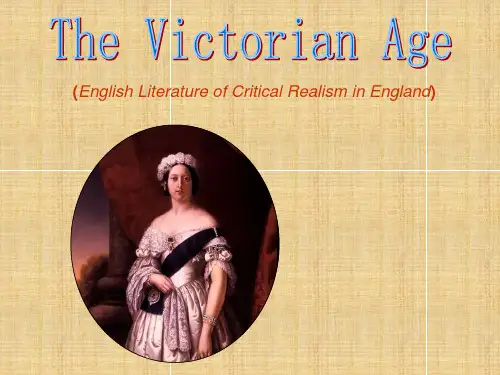
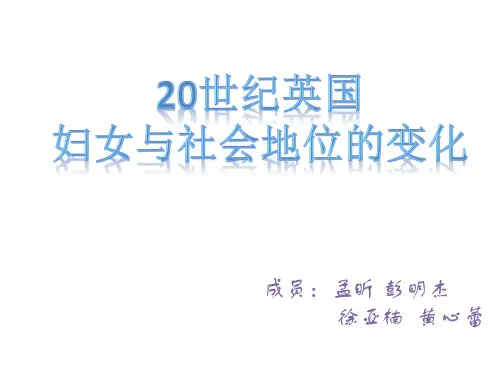

victorian period名词解释
维多利亚时期(Victorian period)指的是1837年至1901年之间,维多利亚女王统治英国的时期。
这是英国工业革命的巅峰时期,也是英国经济、文化和科学发展的黄金时代。
维多利亚女王在位期间,英国从一个农业为主的国家转变为一个工业和商业强国,成为了全球最大的经济体。
同时,维多利亚时期也是英国文学、艺术和建筑的重要时期,许多经典作品和建筑在这一时期诞生。
此外,维多利亚女王本人也成为了一个文化象征,她的形象和价值观影响了整个欧洲和北美。
六.维多利亚时期(Victorian Era 1837年—1901年)查尔斯·狄更斯(Charles Dickens)杰出的小说家,批判现实主义(Critical Realism)的代表人物。
代表作《波兹特写》(Sketches by Boz),《匹克维克外传》(The Posthumous Papers of the Pickwick Club),《雾都孤儿》(Oliver Twist),《老古玩店》(The Old Curiosity Shop),《美国札记》(American Notes),《董贝父子》(Dombey and Son),《大卫·科波菲尔》(David Copperfield),《荒凉山庄》(Bleak House),《艰难时世》(Hard Times),《双城记》(A Tale of Two Cities),《远大前程》(Great Expectations)。
威廉·麦克皮斯·萨克雷(William Makepeace Thackeray):杰出的批判现实主义(Critical Realism)的小说家。
代表作长篇小说《名利场》(Vanity Fair),《亨利·艾斯蒙德》(Henry Esmond),《纽可姆一家》(The Newcomers)。
勃朗特三姐妹(The Bronte Sisters):夏洛特·勃朗特(Charlotte Bronte)的《简爱》(Jane Eyre);艾米丽·勃朗特(Emily Bronte)的《呼啸山庄》(Wuthering Heights);安尼·勃朗特(Anne Bronte)的《安格尼斯·格雷》(Agnes Grey)。
乔治·艾略特(George Eliot):著名的现实主义女作家。
代表作《亚当·比德》(Adam Bede),《弗罗斯河上的磨坊》(The Mill on the Floss),《织工马南》(Silas Marner),《米德尔马契》(Middlemarch—A Study of Provincial Life)。
英国维多利亚时代的历史背景与社会变革维多利亚女王在位期间是英国历史上最长的一个皇后,她的时代也被称为维多利亚时代。
这个时期又被分为早期维多利亚时代(1837-1860年)和晚期维多利亚时代(1860-1901年)。
维多利亚时代是英国历史上重要的一段时期,伴随着工业革命的发展,社会变革也开始在这个时期发生。
一、维多利亚时代的历史背景英国在维多利亚女王即位前的几十年中,正面临着巨大的挑战和变革。
这个时期正处于工业革命的高峰期,这使得英国的经济、政治、社会都面临了大规模的变革。
工业革命使得生产方式从手工业向机器大规模生产转移,这也加速了城市化的进程。
城市里的工厂和机器吸引了无数的农民和农村劳动力迁往城市,他们在城市中聚居成为了一个“无资产者”阶层。
这一阶层与传统的贵族阶层形成了鲜明的对比。
英国在这个时期也进行了一系列有关自由和平等的改革,其中最重要的是1832年通过的《改革法案》。
这个法案取消了很多的选举腐败现象和不合理选区,扩大了选民的范围,使得英国的政治体系更加民主化。
这也为后来的新法改革扫清了道路,如1844年的《穷人法庭法案》和1853年的《救济法案》等。
二、维多利亚时代中的社会变革1. 女性的地位提高维多利亚女王在位期间,女性的地位得到了极大的提高,尤其是在英国的政治和社会生活中。
女性参与政治的权利得到了加强,同时,英国政府也开始采取更加积极的措施改善女性受教育程度和就业环境。
2. 职业阶层的变革维多利亚时代出现了一个日益发展的中产阶级。
这个阶级由广泛的社会群体组成,包括建筑师、银行家、工业家、律师、医生、教育家、新闻工作者等等。
中产阶级在经济上的繁荣导致了他们的影响力在英国社会中的增加,同时也为政治和社会生活带来了更多的多样性。
3. 改革的兴起和发展维多利亚时代以及之后的维多利亚时期,英国经历了一系列的改革,包括教育改革、卫生改革、劳工改革、选举改革等等。
这些改革使得英国社会更加民主化和公正,同时也加强了政府与人民之间的联系和沟通。
维多利亚时代是一个怎样的时代维多利亚时代是一个对罪恶零容忍、主张性节制一个非常严格的时代。
维多利亚时代(英文:Victorian era),前接乔治王时代,后
启爱德华时代,维多利亚时代后期是英国工业革命和大英帝国的峰端,与爱德华时代一同被认为是大英帝国的黄金时代。
它的时限常被定义为1837年至1901年,即维多利亚女王(Alexandrina Victoria)的统治时期。
此长时期的和平,繁荣得以更加细化英国的理性发展,并巩固了大英帝国的国家自信.部分学者认为,1832年改革法案的1832年才是该时期理性与政治发展的真正开端。
许多社会历史学或文学将此时期之风格标定为维多利亚时期或
维多利亚风格,尤其是在讨论十九世纪中后期当时文化风俗与人民普遍态度时。
针对维多利亚时代的研究很多着重于所谓“维多利亚时代道德观念”,包含了高度的道德操守,与细致的语言和行为规范。
8. The Modern Echo of English Literature--Victorian PeriodVictorian Era:The Victorian era of British history was the period of Queen Victoria's reign from 20 June 1837 until her death on 22 January 1901. It was a long period of peace, prosperity, refined sensibilities and national self-confidence for Britain. Some scholars date the beginning of the period in terms of sensibilities and political concerns to the passage of the Reform Act 1832.Queen Victoria:Queen Victoria married her first cousin, Prince Albert, in 1840. Their nine children and 26 of their 34 grandchildren who survived childhood married into royal and noble families across the continent, tying them together and earning her the nickname "the grandmother of Europe".Golden Jubileejubilee ['dʒu:bli:] n.纪念或者庆典(特别指周年的)In 1887, the British Empire celebrated Victoria's Golden Jubilee.Diamond JubileeOn 23 September 1896, Victoria surpassed her grandfather George III as the longest-reigning monarch in English, Scottish, and British history. The Queen requested that any special celebrations be delayed until 1897, to coincide with her Diamond Jubilee.Movie: The Young Victoria 《年轻的维多利亚女王》Summaries•The Victorian era was a period of dramatic change that brought England to its highest point of development as a world power.•The early Victorian period (1830~48) saw the opening of Britain’s first railway and its first Reform Parliament, but it was also a time of economic distress. •Although the mid-Victorian period (1848~70) was not free of harassing problems, it was a time of prosperity, optimism, and stability.•In the later period (1870~1901) the costs of Empire became increasingly apparent, and England was confronted with growing threats to its military and economicpreeminence.•The common perception of the period is the Victorians are “prudish, hypocritical, stuffy, [and] narrow-minded”•The extreme inequities between men and women stimulated a debate about women’s roles known as The Woman Question.Literature of the Victorian Period:The drive for social advancement frequently appears in literature. This drive may take many forms. It may be primarily financial, as in Charl es Dickens’s Great Expectations 《远大前程》. It may involve marrying above one’s station, as in Charlotte Bronte’s Jane Eyre《简·爱》. It may also be intellectual or education-based. Typically, any such attempt to improve one’s social standing must be accompanied by “proper” behavior (thus helping to provide the period with its stereotype).维多利亚时期被文史家们分为三个阶段:维多利亚早期(1832~1848)、维多利亚中期(1848~1870)和维多利亚晚期(1970~1891)。